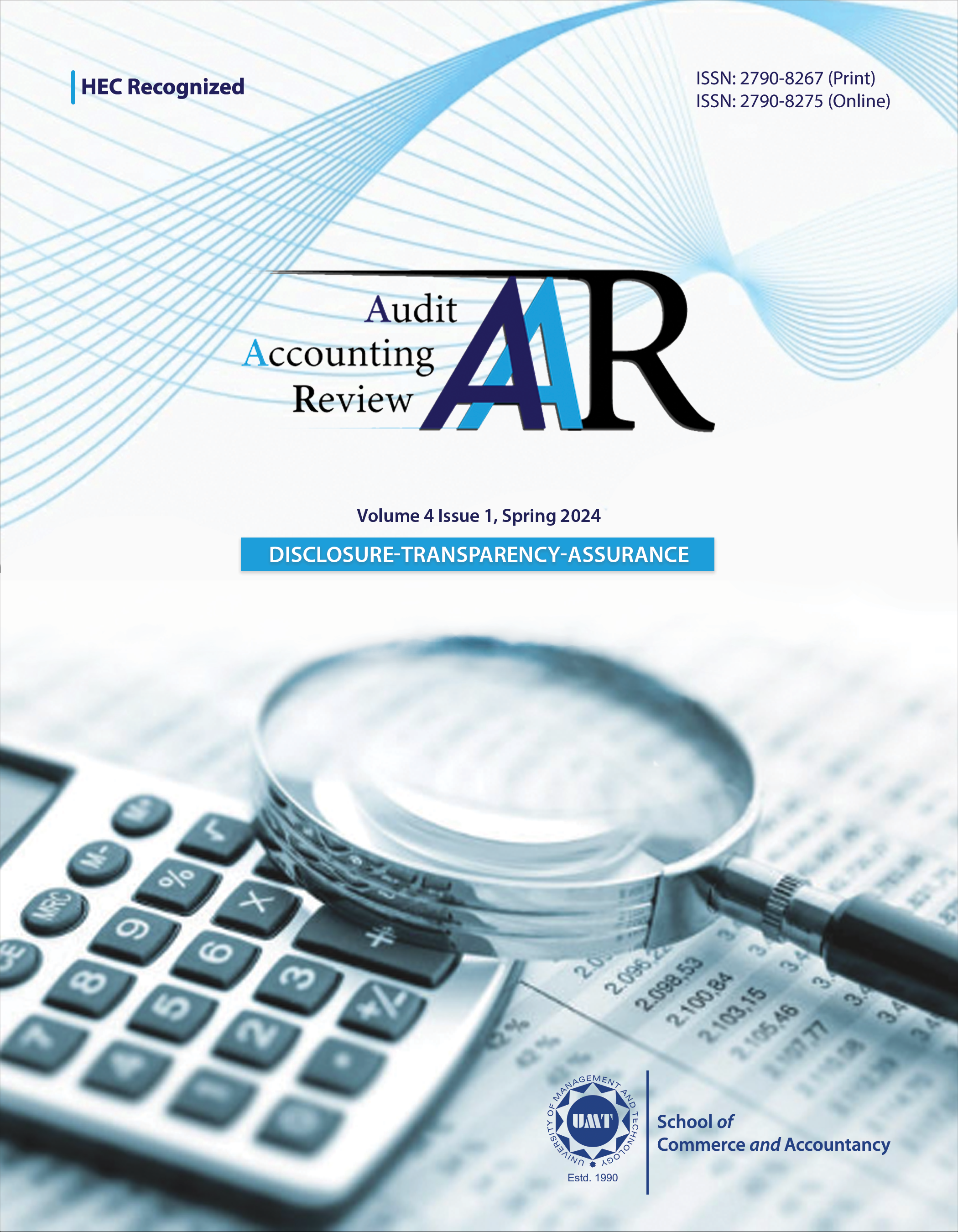A Sectoral Perspective for Unveiling Earnings Manipulation: Evidence from Pakistani Non-Financial Firms
Abstract
 Abstract Views: 0
Abstract Views: 0
The major issue with the financial statement is earnings management (EM). The problem has a long history of documentation in accounting theory and practice. Researchers have employed a variety of models to identify earnings manipulation (EMN) in different economies. However, the Pakistani setting has been the focus of very few studies on this issue. The current study is an attempt to determine whether EMN exists in any of Pakistan's listed non-financial sectors. The study employed data collected from seven primary industries listed on the Pakistan Stock Exchange (PSX) between 2012 and 2019. These industries included cement, chemical, food, oil and gas, manufacturing, sugar, and textile. The study utilized Beneish's (1999) M-Score Model (MSM) to identify the existence of EM. According to the findings, 46% of the Pakistani non-financial companies listed on PSX were engaged in EM. Moreover, the sample chosen also appeared suitable for use with Beneish’s MSM. The conclusion indicated that MSM can be successfully used by businesses to determine EMN. The results can be used by bankers and investors to identify the instances of EMN in financial statements. Moreover, the results can also be used to improve the caliber of financial reporting. Academics and professionals interested in predicting future profits should also take note of the outcomes.
Downloads
References
Abid, G., & Ahmed, A. (2014). Failing in corporate governance and warning signs of a corporate collapse. Pakistan Journal of Commerce and Social Sciences, 8(3), 846–866.
Ajayi-Nifise, A. O., Olubusola, O., Falaiye, T., Mhlongo, N. Z., & Daraojimba, A. I. (2024). A review of U.S. financial reporting scandals and their economic repercussions: Investigating their broader impact and preventative measures. Finance & Accounting Research Journal, 6(2), 183–201. https://doi.org/10.51594/farj.v6i2.787
Anh, N. H., & Linh, N. H. (2016). Using the m-score model in detecting earnings management: Evidence from non-financial Vietnamese listed companies. VNU Journal of Science: Economics and Business, 32(2), 14–23.
Aris, N.A., Othman, R., Maznah, S., Arif, M., Affendi, M., & Malek, A. (2013, June 23–26). Fraud detection: Benford’s law vs Beneish model [Paper presentation]. IEEE Symposium on Humanities, Science and Engineering Research (SHUSER, 2013), Penang, Malaysia.
Bartov, E. (1993). The timing of asset sales and earnings manipulations. The Accounting Review, 68(4), 840–855.
Baskaran, S., Nedunselian, N., Ng, C. H., Mahadi, N., & Abdul Rasid, S. Z. (2020). Earnings management: A strategic adaptation or deliberate manipulation? Journal of Financial Crime, 27(2), 369–386. http://dx.doi.org/10.1108/JFC-07-2019-0098
Beneish, M. D. (1999). The detection of earnings manipulation. Financial Analysts Journal, 55(5), 24–36. https://doi.org/10.2469/faj.v55.n5.2296
Beneish, M. D. (2001). Earnings management: A perspective. Managerial Finance, 27(12), 3–17. http://dx.doi.org/10.1108/03074350110767411
Beneish, M. D., Lee, C. M. C., & Nichols, C. (2013). Earnings manipulation and expected returns. Financial Analysts Journal, 69(2), 57–82. https://doi.org/10.2469/faj.v69.n2.1
Busirin, M. F., Azmi, N. A., & Zakaria, N. B. (2015). How effective is board independence to the monitoring of earnings manipulation? Procedia Economics and Finance, 31, 462–469. http://dx.doi.org/10.1016/S2212-5671(15)01177-6
Busirin, M. F., Zakaria, N. B., Azmi, N. A., & Hermawan, A. (2016). Has the board been effective enough to look after the earnings manipulation exercise? International Journal of Economics and Management, 10(S2), 463–481.
Chen, Y., Chen, C., & Huang, S. (2010). An appraisal of financially distressed companies’ earnings management: Evidence from listed companies in China. Pacific Accounting Review, 22(1), 22–41. http://dx.doi.org/10.1108/01140581011034209
Christianto, W. (2014). The effect of earnings manipulation with using M-score on stock return (empirical evidence in Indonesia listed companies on LQ45 at Indonesia stock exchange period 2009-2011) [Bachelor’s thesis]. University of Atma Jaya Yogyakarta. https://e-journal.uajy.ac.id/6143/1/EAI017993.pdf
Dechow, P. M., Ge, W., Larson, C. R., & Sloan, R. G. (2011). Predicting material accounting misstatements. Contemporary Accounting Research, 28, 17–82. https://doi.org/10.1111/j.1911-3846.2010.01041.x
Dechow, P. M., Sloan, R. G., & Sweeney, A. P. (1996). Causes and consequences of earnings manipulation: An analysis of firms subject to enforcement actions by the SEC. Contemporary Accounting Research, 13(1),1–36. https://doi.org/10.1111/j.1911-3846.1996.tb00489.x
Ernst & Young. (2010). Driving ethical growth–new markets, new challenges 11th Global Fraud Survey. EYGM Limited. https://linomartins.wordpress.com/wp-content/uploads/2011/12/2011th_global_fraud_survey.pdf
Fields, T. D., Lys, T. Z., & Vincent, L. (2001). Empirical research on accounting choice. Journal of Accounting and Economics, 31(1-3), 255–307. https://doi.org/10.1016/S0165-4101(01)00028-3
Gatla, R. (2022). Financial accounting theory and reporting practices. AG Publishing House.
Goncharov, I. (2006). Earnings management and its determinants: Closing gaps in empirical accounting research. Peter Lang.
Gu, Z., Lee, C.-W. J., & Rosett, J. (2005). What determines the variability of accounting accruals? Review of Quantitative Finance and Accounting, 24(3), 313–334. https://doi.org/10.1007/s11156-005-6869-1
Halilbegovic, S., Celebic, N., Cero, E., Buljubasic, E., & Mekic, A. (2020). Application of Beneish m-score model on small and medium enterprises in Federation of Bosnia and Herzegovina. Eastern Journal of European Studies, 11(1), 146–163.
Healy, P. M., & Wahlen, J. M. (1999). A review of the earnings management literature and its implication for standard setting. Accounting Horizons, 13(4), 365–383. https://dx.doi.org/10.2139/ssrn.156445
Jaggi, B., & Tsui, J. (2007). Insider trading, earnings management and corporate governance: Empirical evidence based on Hong Kong firms. Journal of International Financial Management and Accounting, 18(3), 192–222. https://doi.org/10.1111/j.1467-646X.2007.01012.x
Jansen, I. P., Ramnath, S., & Yohn, T. L. (2012). A diagnostic for earnings management using changes in asset turnover and profit margin. Contemporary Accounting Research, 29(1), 221–251 https://doi.org/10.1111/j.1911-3846.2011.01093.x
Jones, J. J. (1991). Earnings management during import relief investigations. Journal of Accounting Research, 29(2), 193–228. https://doi.org/10.2307/2491047
Kaur, R., Sharma, K., & Khanna, A. (2014). Detecting earnings management in India: A sector-wise study. European Journal of Business and Management, 6(11), 11–19.
Khan, M. A. (2022). The impact of earnings management on financial metrics: Insights from Pakistani firms. Journal of Business and Economic Options, 5(3), 34–43.
Khan, S., & Kamal, Y. (2022). Family business groups and earnings manipulation: An emerging economy perspective. Cogent Economics & Finance, 10(1), Article e2017100. https://doi.org/10.1080/23322039.2021.2017100
Kliestik, T., Belas, J., Valaskova, K., Nica, E., & Durana, P. (2021). Earnings management in V4 countries: The evidence of earnings smoothing and inflating. Economic Research-Ekonomska Istraživanja, 34(1), 1452–1470. https://doi.org/10.1080/1331677X.2020.1831944
Kliestik, T., Valaskova, K., Nica, E., Kovacova, M., & Lazaroiu, G. (2020). Advanced methods of earnings management: Monotonic trends and change-points under spotlight in the Visegrad countries. Oeconomia Copernicana/Copernican Economy, 11(2), 371–400. https://doi.org/10.24136/oc.2020.016
Levitt, A. J. (1998). The number game. The CPA Journal, 68(12), 14–19.
Macey, J. R., & Miller J. P. (1990). Good finance, bad economics: An analysis of the fraud-on-the-market theory. Stanford Law Review, 42(4), 1059–1092.
Mahama, M. (2015). Detecting corporate fraud and financial distress using the Atman and Beneish models. International Journal of Economics, Commerce and Management, 3(1), 1–18.
Marinakis, P. (2011). An investigation of earnings management and earnings manipulation in the UK [Doctoral dissertation, University of Nottingham]. Nottingham eTheses. https://eprints.nottingham.ac.uk/12874/
McNichols, M., & Wilson, G. P. (1988). Evidence of earnings management from the provision for bad debts. Journal of Accounting Research, 26, 1–31. https://doi.org/10.2307/2491176
Nwoye, U., Okoye, E. I., & Oraka, A. O. (2013). Beneish model as effective complement to the application of SAS No. 99 in the conduct of audit in Nigeria. Management and Administrative Sciences Review, 2(6), 640–655.
Omar, N., Koya, R. K., Sanusi, Z. M., & Shafie, N. A. (2014). Financial statement fraud: A case examination using Beneish model and ratio analysis. International Journal of Trade, Economics and Finance, 5(2), 184–186. https://doi.org/10.7763/IJTEF.2014.V5.367
Paolone, F., & Magazzino, C. (2014). Earnings manipulation among the main industrial sectors. Evidence from Italy. Economia Aziendale Online, 5(4), 253–261.
Petra, S., & Spieler, A. C. (2020). Accounting scandals: Enron, Worldcom, and global crossing. In H. K. Baker, L. Purda-Heeler & S. Saadi (Eds.), Corporate fraud exposed: A comprehensive and holistic approach (pp. 343–360). Emerald Publishing Limited. https://doi.org/10.1108/978-1-78973-417-120201022
Razali, W. A. A. W. M., & Arshad, R. (2014). Disclosure of corporate governance structure and the likelihood of fraudulent financial reporting. Procedia-Social and Behavioral Sciences, 145, 243–253. http://dx.doi.org/10.1016/j.sbspro.2014.06.032
Ronen, J., & Yaari, V. (2006). Earnings management: Emerging insights in theory, practice, and research. Springer. http://dx.doi.org/10.1007/978-0-387-25771-6
Roy, C., & Debnath, P. (2015). Earnings management practices in financial reporting of public enterprises in India: An empirical test with m-score. Social Science Research Network, Article e2551713. http://dx.doi.org/10.2139/ssrn.2551713
Saleem, F., Alifiah, M. N., & Tahir, M. S. (2016). The effectiveness of monitoring mechanisms for constraining earnings management: A literature survey for a conceptual framework. International Journal of Economics and Financial Issues, 6(S3), 209–214.
Schipper, K. (1989). Commentary on earnings management. Accounting Horizons, 3(4), 91–102.
Sharpe, W. F. (1964). Capital asset prices: A theory of market equilibrium under conditions of risk. The Journal of Finance, 19(3), 425–442. https://doi.org/10.1111/j.1540-6261.1964.tb02865.x
Stolowy, H., & Breton, G. (2004). Accounts manipulation: A literature review and proposed conceptual framework. Review of Accounting and Finance, 3(1), 5–92. http://dx.doi.org/10.1108/eb043395
Sultana, F, Siddiqui, M. A., Kashif, M., Hanif, M. W., & Kalsoom, S. (2022). Earnings management cosmetics and tricks: An exploratory study. Journal of Hunan University Natural Sciences, 49(10), 146–162. https://doi.org/10.55463/issn.1674-2974.49.10.17
Walker, M. (2013). How far can we trust earnings numbers? What research tells us about earnings management. Accounting and Business Research, 43(4),445–481. http://dx.doi.org/10.1080/00014788.2013.785823
Warshavsky, M. (2012). Analyzing earnings quality as a financial forensic tool. Financial Valuation and Litigation Expert Journal, 39, 16–20.
Copyright (c) 2024 Faiza Saleem, Farhan Shahzad, Kamran Ahmed

This work is licensed under a Creative Commons Attribution 4.0 International License.
Authors retain copyright and grant the journal right of first publication with the work simultaneously licensed under a Creative Commons Attribution (CC-BY) 4.0 License that allows others to share the work with an acknowledgement of the work’s authorship and initial publication in this journal.




